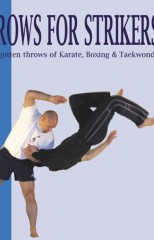
Author : Abernethy Iain
Title : Throws for strikers The Forgotten Throws of Karate, Boxing and Taekwondo
Year : 2003
Link download : Abernethy_Iain_-_Throws_for_strikers.zip
Introduction. In recent times, more and more martial artists are critically reevaluating the effectiveness of their chosen art. The need for skills at all ranges of combat is now more widely understood. You could be the best kicker in the world, but if you don’t know how to grapple you will be easily defeated if your opponent gets inside kicking range (which isn’t that hard to do). Also, just suppose that you’re a great wrestler, but have had no exposure to striking. It may take you longer to defeat an opponent (strikes being a quicker way to end fights), you will be very vulnerable to strikes and, most importantly of all, you will not have the ability to ‘stun and run’, which is vital for effective self-protection. A chain is only as strong as its weakest link. To be a truly effective fighter, you will need to be conversant with all ranges of combat. This realisation has lead to strikers learning how to grapple, and grapplers learning to strike. However, one question that needs to be asked is, ‘why doesn’t the art you already practise have those missing skills on its curriculum?’ If the original martial arts were designed for use in real combat, then why are there such glaring omissions? Over the last century, the martial arts have undergone many significant changes. Most important of all has been a fundamental change to the goals of training. The original goal of all the martial arts was the defeat of an opponent in military or civilian combat, but the focus of many systems has now changed. Most practitioners of the martial arts, whether they realise it or not, now train for physical development or sport. For the practitioner who trains in the martial arts to stay in shape, it does not really matter if all ranges of combat are practised. All that is needed is for the training to be physically taxing enough to improve their level of fitness. Likewise, if the same practitioner has the necessary muscle control, flexibility and physical strength to perform the various physical movements, katas, forms, prearranged techniques etc, it is irrelevant whether they have the skill to actually apply those movements in live combat. In today’s martial arts, mastery of physical movement is often all that is required to advance through the grades. Hence, we have the situation where many higher grades, though technically competent, are not actually able to apply what they have learnt in live situations. The other modern trend in the martial arts is the shift towards sport. In this instance, the goal is the acquisition of trophies and titles through the defeat of practitioners of the same discipline in a rule-bound environment. This evolution has seen those techniques that are not associated with sporting success fall by the wayside. Karate, boxing, taekwondo etc have always favoured striking methods, and that is why their sporting versions have evolved into solely striking affairs. Judo, on the other hand, has always favoured grappling. Judo did originally contain striking techniques. However, the rules of competitive judo prohibit striking, hence you would now find it fairly difficult to find a judo club that teaches striking. The older versions of karate and taekwondo contained throws, joint-locks, strangles etc. Again, many of these techniques are now banned in the modern sporting versions of karate and taekwondo, and therefore very few schools now teach the grappling side of those arts. Not only do these modern evolutions limit the techniques available to the art’s practitioners, they also increase their vulnerabilities. For example, because wrestlers never have to face kicks and punches in a competitive bout, they are never exposed to strikes and are therefore unlikely to be able to deal with them effectively. Conversely, the modern boxer will be highly skilled at dealing with punches, but will be vulnerable to kicks, throws etc. The original fighting arts were for use in real combat, and therefore they covered all ranges. The karateka of the past covered throwing, grappling, locking etc in their training (see my books, Karate’s Grappling Methods and Bunkai-Jutsu: The Practical Application of Karate Kata). So did boxers, kung-fu stylists and practitioners of what became known as taekwondo. A quick look through the history books, and an examination of the traditional forms, reveals grappling techniques in abundance. Karate was strongly influenced by many differing styles of Chinese boxing. This included the methods of Shuai Jiao (a form of Chinese wrestling that is said to date back to 2000 BC) and Chin-Na (seizing and joint locking). Karate has also been influenced by the native Okinawan grappling art of Tegumi and, to a lesser degree, the Aiki-Jujitsu systems of the Japanese samurai. Boxing also used to contain many grappling and throwing techniques. It is believed that modern boxing (and wrestling) evolved from the Greek art of Pankration (meaning ‘all powerful’). This art contained strikes, holds, throws, ground fighting and submissions. Greek mythology states that both Hercules and Theseus were skilled in the art of Pankration. In more recent times, there is an abundance of records that refer to boxers using grappling and throwing techniques. As an example, James Figg – who was the first ever bare-knuckle boxing champion of England – defended his title against Ned Sutton in 1727. It is recorded that Figg winded Sutton by throwing him on his back, and that Figg eventually won the bout by knocking Sutton down and pinning him until he submitted! These techniques are now never seen in the modern sport of boxing. However, they were a part of the original system. Boxing was taught as a self-defence system to society gentlemen. The first gloves were developed so that they could practise the art without picking up bumps and bruises that were not befitting their status. Throwing was also considered to be an important part of the self-defence side of boxing. Taekwondo is a relatively modern art, the name ‘taekwondo’ first being used in 1955. However, it is said that its origins go back much further. Taekwondo is based on the warrior art of Tae Kyon, which was formulated by the warriors of the Koguryo kingdom and was then spread to the whole of Korea by the Hwarang (warrior class) of the Silla kingdom. The Korean arts of Subak, Kwonbop and Cireum (a wrestling art based on Chinese and Mongolian systems) are also said to have influenced the development of what became taekwondo. Chinese kempo and in particular Okinawan and Japanese karate have also influenced modern taekwondo. Indeed, many of the original taekwondo forms were based on the karate katas. These ‘common forms’ mean that taekwondo will also have been influenced by Okinawan and Japanese grappling and throwing techniques. Whilst grappling is not a commonly practised part of the art today, we can see that grappling techniques were a part of the systems upon which the modern art of taekwondo is based. Although many styles of kung-fu are now practised as striking only systems, wrestling and joint-locking are traditionally regarded as a standard part of all Chinese martial arts. Traditional kung-fu is said to be made up of four sections: striking, kicking, wrestling and joint-locks. We have already discussed how the methods of Chinese wrestling have influenced karate and taekwondo. The Japanese methods of jujitsu (upon which modern judo is based) were also hugely influenced by Chinese grappling methods. As with karate and taekwondo, a study of the traditional forms will often reveal many grappling and throwing techniques. Not only did the striking arts originally contain grappling and throwing techniques, grappling arts such as wrestling, judo, aikido etc also originally contained striking techniques. It is only in relatively recent times that the martial arts have narrowed their focus. However, this narrowing of focus has had a positive side. Because the vast majority of boxers have now abandoned the grappling side of their art to concentrate solely on punching, they have become exceptional punchers. Judoka are without a doubt the premier throwers of the martial arts community due to the heavy focus they now place on throwing. The original arts, although much more broad based, were not as sophisticated as their modern counterparts. The modern practitioners of the various arts have taken certain aspects to levels never dreamed of by their predecessors, and this has benefited the martial arts as a whole. However, some aspects of these increased levels of sophistication can bring their own problems, which we will discuss in the following chapter. It must also be understood that communication was very limited during the times our arts were being developed. Today, it is possible to learn many arts from all over the world. In the past, however, people would only be able to study with practitioners who lived in their local area. For example, the boxers of England would not have been able to study with the jujitsu practitioners of Japan. This is one more reason why the techniques of the older arts are not always as sophisticated as those we have access to today. This lack of sophistication does not mean these techniques are ineffective, far from it. However, it must be said that the ‘forgotten’ aspects of the older arts are often not as refined as the techniques of those arts now dedicated to particular skills (as you would expect). If effective fighting skills are your aim, then you need to include all ranges of combat in your training. There are essentially two ways to ensure that your training is broad based. The first is to study a variety of arts (‘cross-training’ as it is often called). For example, you may study boxing for your punches, taekwondo for your kicking, and judo for your grappling. This is obviously a great way to train because you are effectively learning the strongest aspects of the various arts. The downside is that you may become a ‘jack of all trades and a master of none’. And unless you get sufficient guidance from experienced cross-trainers, the various methods can become disjointed with none of the systems being practised gelling together. The second way to ensure your training is broad based is to study the older version of your current art. The advantage of this approach is that you will be learning a single complete and coherent system. The negative side is that the methods of the older version of your art will often not be as sophisticated or refined as those of the dedicated grappling arts (and it can also be hard finding an instructor who teaches the older version of the system). If you’re a boxer, you could learn the throws that were once a fundamental part of boxing. If you’re a karate, taekwondo or kung-fu practitioner, you could examine the grappling techniques that are recorded within your forms. You should understand that studying the throwing techniques of the striking arts will in no way make you the equal of a judoka or wrestler when it comes to throws. However, a study of the ‘forgotten’ throws will give you the fundamental throwing skills that may be needed for self-protection. It’s really a matter of what you as an individual require from your training. My personal approach has been to fully study my chosen art (karate), and to examine the methods of dedicated grappling arts to increase my understanding of the techniques already present in my base system. However, as I said, it’s really a matter of what works best for you. Some of my training partners and students also study judo, which has not only enhanced their application of the basic throwing techniques found within the traditional forms, but it has also furthered their knowledge and understanding of throwing techniques in general. There are many different aspects to grappling. In this book we will be concentrating on the throws and takedowns that were once a common part of the striking arts. Differing arts may have emphasised certain throws over others, or have performed them in slightly differing ways to those shown here. However, the throws shown in this book are common to many arts (grappling and striking) and, in my opinion, are some of the most effective throws for use in self-defence. Exploring all the throws originally found in what are now called the ‘striking systems’ would be a huge task. It is hoped that the throws covered in this book will help you to further explore the specific throws found within your own system. You may not perform the throws covered in exactly the same way as demonstrated, but the fundamental concepts are common to all systems. What works, works! The purpose of this book is to help practitioners of the striking arts to reintroduce the throwing methods that were once part of their system. This will then allow you to practise your art as its founders originally intended. These throws can obviously also be found in the grappling systems and we will make reference to these arts where appropriate. ...

Demolins Edmond - L'éducation nouvelle
Auteur : Demolins Edmond Ouvrage : L'éducation nouvelle Année : 1898 Lien de téléchargement :...














